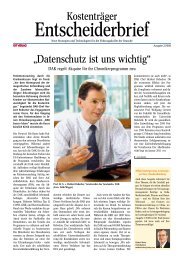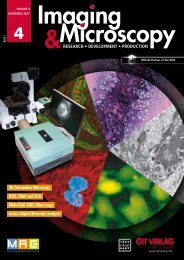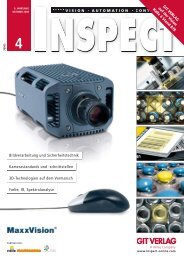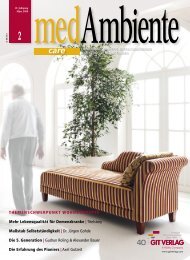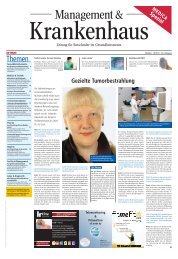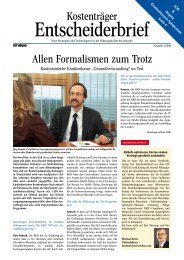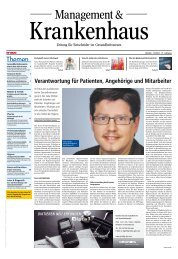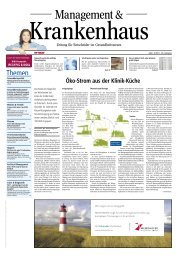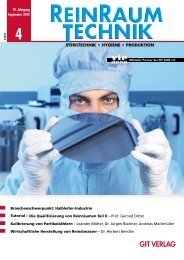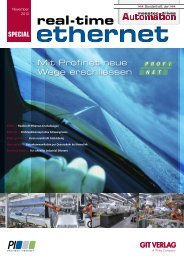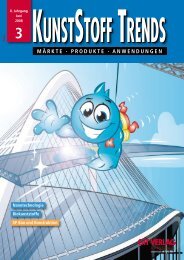Europe - GIT Verlag
Europe - GIT Verlag
Europe - GIT Verlag
Create successful ePaper yourself
Turn your PDF publications into a flip-book with our unique Google optimized e-Paper software.
Hospital Post <strong>Europe</strong> 04/08<br />
Through the implementation<br />
of the German Diagnosis Related<br />
Grouping (DRG) system<br />
and the resulting cost pressure,<br />
the need for optimized<br />
use and operation of the<br />
premises in hospitals is growing.<br />
The link between primary<br />
processes and facility management<br />
(FM) services, however,<br />
is missing. Therefore the<br />
Chair for Facility Management<br />
at the University of Karlsruhe<br />
(Germany) analyzed the interdependencies<br />
between facility<br />
management performance,<br />
costs, and primary processes<br />
in hospitals. This project is abbreviated,<br />
in German, OPIK –<br />
optimization and analysis of<br />
hospital processes.<br />
Process-Oriented Cost Model<br />
The treatment of patients in hospitals can<br />
be described by a clinical path that is interpreted<br />
in terms of space. Figure 1 illustrates<br />
this – the patient’s way through the<br />
hospital follows a certain path, symbolized<br />
by the black line. Along this, the patient<br />
requires specific functions from various<br />
entities. Depending on each function, differing<br />
infrastructure services are necessary<br />
– symbolized by the grey circles. At the<br />
level of space, primary and infrastructure<br />
processes are linked through the functional<br />
units. The focus is set on the patient<br />
and his/her presence in the functional unit.<br />
Any performance is related to this case.<br />
Fig. 1: Patient’s path through the hospital<br />
This relation between FM services and the<br />
primary processes has been described in a<br />
mathematic process modelled by the University<br />
of Karlsruhe.<br />
The model’s quintessence is the<br />
description of the relation of all core infrastructure<br />
processes to a primary process<br />
profile. Thus, a value from the primary<br />
process has been assigned to each relevant<br />
main FM process. For the operation room<br />
(OR) – of key importance –, the cost dominant<br />
process “sterile goods supply” is discussed<br />
in the following as an example. The<br />
results are based on the analysis of empirical<br />
data of four German hospitals.<br />
Sterile Goods Supply<br />
in the OR<br />
Figure 2 shows the average cost shares of<br />
the FM processes for the OR: 39 % of the<br />
costs are related to the process “sterile<br />
goods supply”. Therefore, this process is<br />
paramount for the OR.<br />
Fig. 2: Average FM cost share for the functional unit operation of<br />
four hospitals<br />
FAcILItY MAnAGEMEnt 27<br />
FM Cost in the OR<br />
Cost Driver<br />
The relation between primary and FM<br />
processes can be separated into fixed and<br />
variable costs. “Sterile goods supply” is<br />
part of the variable costs. When changing<br />
intervention activities in the OR from one<br />
shift to two shifts per day and assuming<br />
similar workload, it may be assumed that<br />
these costs will double in a linear manner.<br />
According to the standard of the German<br />
“Institut für das Entgeltsystem im Krankenhaus”<br />
(InEK), the basis of the allocation,<br />
and therefore abstract cost driver for the<br />
costs of the medical and non-medical infrastructure<br />
in the OR, is the time between<br />
first incision of the skin and last suture plus<br />
the setup time for each intervention. This<br />
approach is simplistic in assuming that all<br />
infrastructure costs are linear dependent<br />
on the length of the intervention. Time is<br />
the only cost driver. For a transparent analysis<br />
of costs and for the purpose of benchmarking<br />
and optimization of FM products,<br />
the relation between cost and cost driver<br />
has to be examined in detail.<br />
Does an intervention of double length<br />
really mean a doubled effort for sterilization<br />
and packing of the surgical kits? The<br />
cost driver for sterile goods supply is, rather,<br />
the number, and content of surgical kits<br />
– i.e. the type of intervention rather than<br />
the procedure time. A problem occurs<br />
when large surgical kits are opened just for<br />
the use of one or two elements: the unused<br />
content has to be sterilized and repacked.<br />
To avoid this needless effort, there has<br />
to be good communication between surgeons,<br />
medical staff, and the sterilization<br />
Texcare International – New Technologies<br />
Early in June, the international<br />
tradeshow for textile handling<br />
took place in Frankfurt/<br />
Germany. Around 15,500 trade<br />
visitors from 80 countries<br />
came to discuss solutions and<br />
products from 258 exhibitors<br />
who included “big names”<br />
such as Kannegiesser, Jensen-<br />
Group, Lavatec, Pellerin Milnor,<br />
Alliance, Renzacci, Girbau,<br />
Multimatic ilsa, Miele, and<br />
Ecolab. More than half of the<br />
attendees travelled to Frankfurt<br />
from outside Germany.<br />
The portfolio of the show included laundry<br />
and dry-cleaning machines, logistics<br />
and transport, finishing and ironing equip-<br />
ment, as well as linen hire and research.<br />
“The Texcare Forum was also given a good<br />
reception by all visitors and well attended,”<br />
said Friedrich Eberhard, Vice President<br />
of the German Dry Cleaning Association.<br />
“The most important topics at this year’s<br />
Texcare were: energy efficiency, environmental<br />
conservation, and the linkage of<br />
mechanical units for greater efficiency and<br />
economy.”<br />
New technologies supporting logistics<br />
were also at the top of the agenda – in particular<br />
at the booths of Tagsys, Sokymat –<br />
where the Miniature Laundry Tag S-Tag10<br />
was presented – and Datamars.<br />
The Swiss RFID specialist Datamars announced,<br />
in Frankfurt, a partnership with<br />
the Dutch logistics vendor ABS Laundry<br />
Business Solutions. A modular approach<br />
is the partners’ reply to increasing demand<br />
in handling industrial and rental textiles,<br />
speakers said at the press conference.<br />
“Our objective is to ensure that [RFID]<br />
technology is accessible to businesses of all<br />
sizes, by bundling hardware and software<br />
components to deliver total customized<br />
ID solutions that are affordable and truly<br />
meet the individual needs and budgets of<br />
our customers. Our alliance with the leading<br />
automation and logistics solutions provider<br />
for the textile rental business worldwide,<br />
ABS, reflects this objective,” underlined<br />
Ken Boyle, Chief Marketing Officer at<br />
Datamars.<br />
The next Texcare is to take place four<br />
years from now.<br />
Michael Reiter<br />
department. Standardized surgical kits<br />
should be used for routine interventions<br />
and the documentation should be made<br />
available for FM purposes.<br />
The average costs for sterile goods<br />
supply for the operation of a hip joint in<br />
2005 – based on the information from four<br />
hospitals – is about € 190 with an average<br />
number of sterile goods entities of 5.5. The<br />
average cost for sterile goods supply for any<br />
intervention is only € 58. This difference<br />
can be related to the average intervention<br />
time, including setup, for a hip joint: the<br />
reference time is about 190 minutes. The<br />
average time for the different intervention<br />
portfolios in the hospitals of the research<br />
sample varies between 72 and 165 minutes.<br />
Considering the possible time span of<br />
interventions and the cost differences for<br />
sterile goods supply for a relatively short<br />
but complex kind of intervention – as in<br />
the case of a hip joint surgery –, the need<br />
for transparent, realistic cost allocation be-<br />
comes clear. For sure, the cost for sterile<br />
goods supply can not properly be set in<br />
relation with intervention time.<br />
The University of Karlsruhe is developing<br />
a model that allows a realistic cost<br />
allocation for FM processes. Thus, the<br />
researchers are linking FM processes and<br />
the primary process for the function areas<br />
in the hospital. This is an important step<br />
towards cost transparency, and gives a very<br />
important basis for strategic planning of<br />
resources in the hospital.<br />
Contact:<br />
Dipl.-Ing. Karin Diez<br />
Prof. Kunibert Lennerts<br />
University of Karlsruhe (TH)<br />
Facility Management<br />
D-Karlsruhe<br />
Tel.: +49 721/608 8225<br />
Fax: +49 721/608 4351<br />
karin.diez@uni-karlsruhe.de<br />
www.facility-management.<br />
uni-karlsruhe.de<br />
Significant Effect on Skin Flora<br />
Trevira Bioactive is kind to<br />
the skin – as confirmed by a<br />
study of the Hohenstein Institute,<br />
which specializes in the<br />
physiology of clothing.<br />
Can wearing antimicrobial clothing in Trevira<br />
Bioactive exercise a negative effect<br />
on the skin flora? Does Trevira Bioactive<br />
influence other parameters of a skin-physiological<br />
nature? Evaluation of a four-week<br />
wearer trial should supply answers to these<br />
questions. The testers came to the conclusion<br />
that the antimicrobial activity of the<br />
fibres had no harmful effect on the skin flora,<br />
even after being worn for some considerable<br />
time. They were unable to establish<br />
any negative impact by the textile fibres on<br />
the flora, either in the case of individual<br />
trial participants or taking the whole participant<br />
group into consideration. In the<br />
wearer trials where Trevira Bioactive was<br />
compared with conventional textiles, it was<br />
not possible to establish any noticeable dif-<br />
Renovation Work in Jordania<br />
Thanks to the funding of the<br />
United States Agency for International<br />
Development (US-<br />
AID), renovation and expansion<br />
work in the Maan hospital<br />
in Jordan is now complete.<br />
The upgraded facilities were inaugurated<br />
in the middle of May by the Minister of<br />
Health Salah Mawajdeh and USAID Mission<br />
Director Jay Knott. The new facilities include<br />
a renovated delivery ward, obstetrics<br />
and paediatric departments, and operating<br />
theatre. After the renovation, the hospital<br />
is equipped with state-of-the-art medical<br />
equipment and furniture which are crucial<br />
to the safety and quality of the services<br />
provided to the women and newborns in<br />
Maan, according to a statement released<br />
by USAID.<br />
The renovation work was designed to<br />
meet the functional, infrastructure, and<br />
infection control requirements in accordance<br />
with international standards (AIA-<br />
ference in the total number of germs on<br />
the skin. In addition, the most important<br />
indicator of the protective function of the<br />
skin, “transepidermal water loss” (TEWL),<br />
stays unchanged when wearing Trevira Bioactive.<br />
There is also no alteration in the pH<br />
value and surface temperature of the skin.<br />
In comparison: in contrast to wearing<br />
clothing made from permanently antimicrobial<br />
polyester fibres, alcoholic skin<br />
disinfection has a significant effect on skin<br />
flora. By virtue of a silver additive that is<br />
firmly anchored in the raw material, Trevira<br />
Bioactive fibres prevent the growth<br />
of bacteria on the fibre surface. The effect<br />
is permanent and is not affected by either<br />
washing or usage. Furthermore it prevents<br />
odours forming and textiles stay fresh for<br />
longer. The vital factor is that in all this the<br />
effect is limited to the textile.<br />
www.trevira.com<br />
American). Furthermore, the staff of the<br />
Maan Hospital was also provided with clinical<br />
guidelines and trained how to use and<br />
maintain the new equipment in the obstetrics<br />
and neonatal departments.<br />
The Maan hospital – built in 1950 –<br />
serves about 100,000 people. Before the<br />
renovation work, a lot of Maan residents<br />
had to travel to Aqaba because of the limited<br />
services provided by the hospital. Now,<br />
medical treatment improved considerably<br />
and the people no longer need to take a<br />
trip.<br />
After renovating Maan hospital, renewals<br />
and expansion work of other hospitals<br />
will follow. The primary objective of the<br />
USAID’s Health Systems Strengthening<br />
project is to improve the health status of all<br />
Jordanians. Coverage and access to needed<br />
services for all citizens should be improved<br />
to provide high-quality and client-oriented<br />
care.<br />
CK





